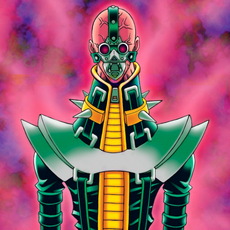
Monster Cards have a number of different elements to them, which you can use to your advantage during a Duel. To begin, let's examine a classic card, "Jinzo".
Most cards have a name, the only time you will see ones without them are due to printing errors. In this example, this name is present in gold foil lettering. Typically, this indicates that the card is of a high rarity.
Most Monster Cards have a Level. In this example, we see that "Jinzo" is a Level 6 monster. This means that you need to Tribute 1 monster to Tribute Summon it; Tribute Summons will be explained in detail later on.
Note that - only in the Yu-Gi-Oh! 5D's Anime - Dark Synchro Monsters have a "negative" level. Instead of red and yellow stars spanning from right to left; they feature blue and black stars moving from left to right.
Note that Xyz Monsters do not have level: they instead have ranks. They feature black and yellow stars spanning from left to right, similar to Dark Synchro monsters. Link Monsters also do not have levels, they have Link Ratings which are listed next to their ATK.
All Monster Cards have an "Attribute"; this can be the first step for determining what cards can be used or with or against the card in question. We can see here that "Jinzo" is a DARK monster, able to take advantage of support cards like "Mystic Plasma Zone". Many Support Cards go for either Attribute or Type, and rarely ask for both to be met to fulfill a requirement.

This is the illustration artwork used on every card; some card artworks are edited to reflect cultural differences, as well as to cater to the tendencies of the parents of western children who frequently hold Trading Card Games, and related media responsible, in lieu of good parenting, for spreading unwanted influences to their offspring. The editing of artwork handily bypasses this, though it has been frequently criticized by the more "mature" audience, who objects to the stigma of "playing a children's card game", citing that it was marketed to teenagers and young adults in Japan.
![]()
All Monster Cards have a "Type"; this can often be the second step for determining what cards can be used or with or against the card in question, but often, many Support Cards go for either Attribute or Type, and rarely ask for both to be met to fulfill a requirement.
![]()
A "Lore" is present on all Cards, and provides an overview of how to use the card, or to provide a flavor text where no effect is present.
![]()
ATK and DEF are the fundamentals of battling monsters against each other; generally speaking, the higher the value is, the greater the monster for the related stat. Many card effects can alter ATK and/or DEF, and many cards require monsters with specific ATK and/or DEF values to be activated or used. Link Monsters do not have DEF.
This is an eight-digit number used on most cards, although there are some that lack them or have something else like a notice that states the card cannot be used in a Duel. The numbers correspond to those used in Video Games, enabling players to re-create their Decks in their favorite Video Game.
![]()
This section holds two pieces of information; the first, is to confirm that all Intellectual Property is © Kazuki Takahashi, the original creator of what would become Duel Monsters in Japan. The second piece of information is the "Eye of Anubis" mini-holofoil; Gold designates that it is a Limited Edition or 1st Edition card, while Silver designates that is is an Unlimited Edition card. Both types are designed to tell the player that the card they have is Genuine.
There are four card editions; 1st Edition, Unlimited Edition, Limited Edition and Duel Terminal. These will be explained in greater detail later.
Every card released in the TCG has a Set Number, while all but the earliest OCG cards have one. This is a reference to several pieces of information, such as Language, the Set ID of the Set the card is from, and the order of the card in the set, though it does not list how many cards total are in the set. I.E. if the card has SDP-003, the SD refers to Starter Deck, the P refers to Pegasus, 003 refers to the card in the set.
| Preceeded by. | Current | Succeeded by. |
| What are the different Cards? | Basics of Monster Cards | Introduction to Normal Monsters |